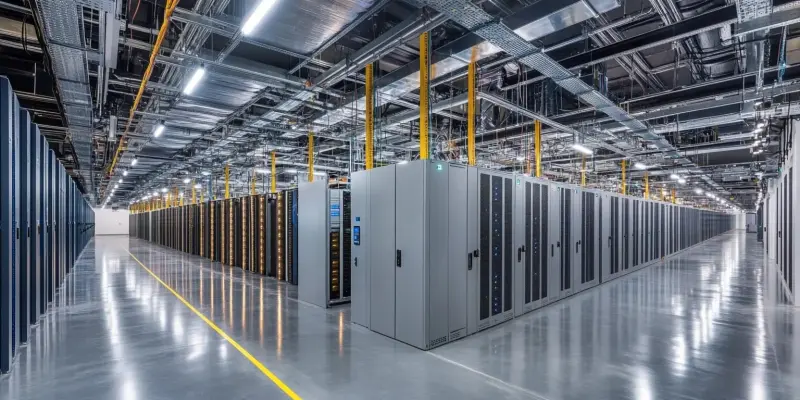Amid rising concerns about the rapid growth in electricity demand from data centers, the Grant County Public Utility District (PUD) in Washington has undertaken significant measures to stabilize its grid infrastructure. As technological advancements, particularly in artificial intelligence, drive exponential increases in power consumption, the PUD has imposed caps on electricity demand primarily from data centers to safeguard grid reliability, ensuring that the existing transmission infrastructure doesn’t become overburdened.
Balancing Industrial Growth with Infrastructure Stability
Implementing Demand Caps
The PUD’s decision to place caps on the electricity demand from data centers comes from the necessity to address physical limitations of the transmission system. This proactive approach ensures that while energy generation remains robust, primarily sourced from the Wanapum and Priest Rapids dams, the delivery of electricity does not compromise the overall system reliability. It is crucial to understand that the challenge lies not in the availability of electricity but in the capacity of the transmission lines to handle increasing loads without failing.
This strategic move places specific restrictions on data centers, allowing them to grow their power usage but within carefully monitored limits. As a result, data centers can expand up to a certain point, with the expectation that by the latter part of the year, they will approach their capped limits. This balancing act is designed to prevent any sudden strain on the electrical infrastructure, thereby maintaining consistent service quality across all sectors. The immediate focus is on preventing overloads while future transmission capacity improvements are underway.
Responding to Growth and Technology Demands
The impetus behind these demand caps stems from the substantial increase in power needs driven by modern technology applications. The surge in artificial intelligence and other data-intensive operations has significantly raised energy requirements, particularly from data center clients. This elevation in demand risks pushing the current infrastructure to its limits, thereby necessitating the PUD’s intervention to manage growth strategically. While data centers face these caps, other sectors, such as commercial, residential, and agricultural customers, currently do not encounter similar limitations, allowing these sectors to grow their electricity usage organically.
The PUD’s measures highlight the delicate balance between supporting technological advancement and safeguarding grid stability. By imposing demand caps on energy-intensive customers, the utility district can address immediate infrastructure concerns while laying the groundwork for future capacity enhancements. This initiative underscores the importance of proactive planning in utility management, ensuring that technological progress does not outpace the physical capabilities of the existing transmission network.
Long-Term Capacity Enhancements
Ongoing Infrastructure Projects
In tandem with the implementation of demand caps, the Grant County PUD is proactively working on enhancing its transmission capacity to accommodate future growth. Key projects include the construction of a new high-capacity transmission line from Wanapum Dam to Quincy. This major infrastructure development, projected for completion within the next two to four years, aims to significantly boost the transmission network’s ability to handle increased loads from data centers and other industrial customers.
Building new transmission lines involves extensive planning, requiring multiple phases of permitting, land usage approvals, and resource procurement. These complex procedures extend the timeline for completion but are critical to ensuring the long-term capacity and reliability of the grid. Once these projects are finalized, the enhanced infrastructure will provide a more robust backbone to support continued regional growth and technological advancements. This forward-looking approach is critical for sustaining a balance between current and future power demands.
Addressing Permitting and Planning Challenges
The extensive delays often associated with new transmission projects are attributed to the layered processes of planning and regulatory compliance. Obtaining necessary permits and land-use approvals involves navigating a maze of bureaucratic steps that can substantially lengthen project timelines. This complexity underscores the importance of extensive upfront planning and engagement with multiple stakeholders to facilitate smoother implementation of large-scale infrastructure upgrades.
Despite these challenges, the PUD’s commitment to expanding transmission capacity is unwavering. By actively pursuing these long-term projects, the utility district aims to create a grid infrastructure that can manage future demands effectively, thereby mitigating risks associated with sudden spikes in electricity usage from burgeoning technologies. This strategic foresight is essential for maintaining grid reliability and supporting the innovative potential of industries dependent on substantial data processing capabilities.
Looking Ahead: Ensuring Future Reliability
With mounting worry over the sharp increase in electricity demand from data centers, the Grant County Public Utility District (PUD) in Washington has taken vital steps to stabilize its grid infrastructure. As technology evolves, especially with advancements in artificial intelligence, there is a skyrocketing rise in power consumption. In response, the PUD has implemented limitations primarily targeting electricity demand from data centers. This strategic move is intended to protect the reliability of the grid, ensuring that the current transmission infrastructure is not excessively strained. By imposing these demand caps, the PUD aims to manage the unprecedented energy needs effectively and prevent potential overloading, thus maintaining a stable and dependable power supply for the community. These efforts reflect a proactive approach to balancing the technological demands with the region’s energy capabilities, highlighting the importance of foresight and planning in the face of rapid technological progress.

